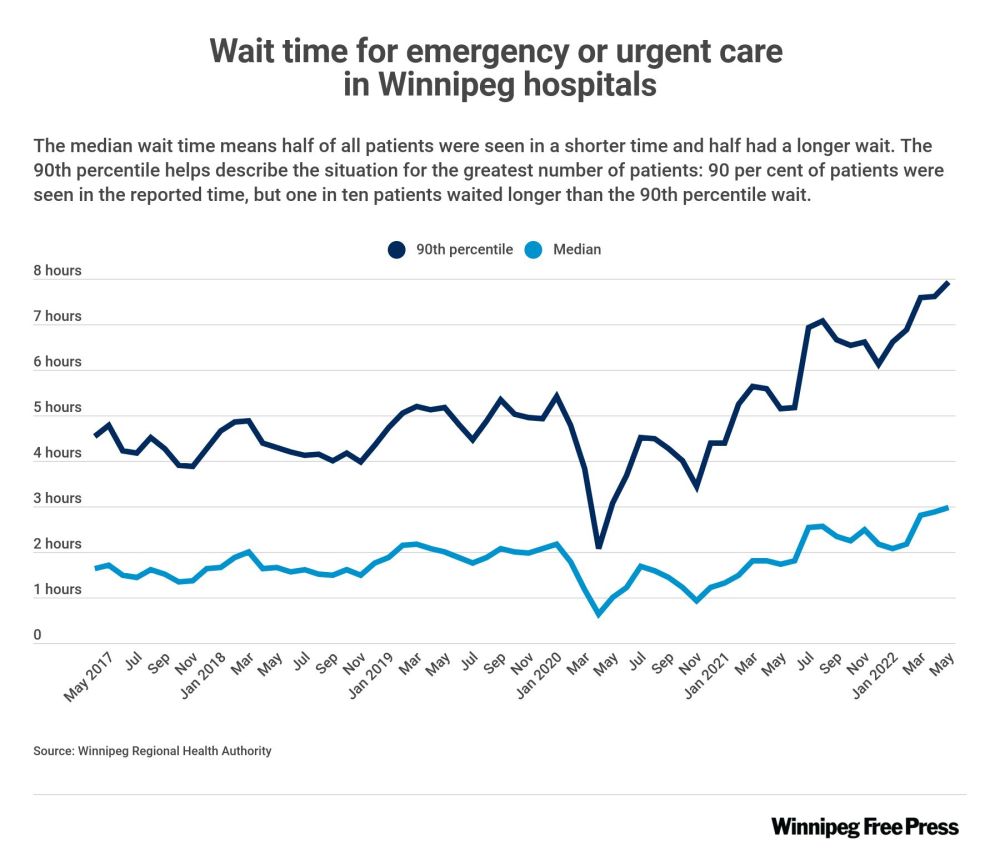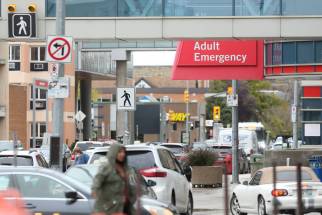Tight-fisted Tories stand pat as Winnipeg ER, urgent-care wait times soar Hospital consolidation, inadequate funding drive staffing crisis
Read this article for free:
or
Already have an account? Log in here »
To continue reading, please subscribe:
Monthly Digital Subscription
$0 for the first 4 weeks*
- Enjoy unlimited reading on winnipegfreepress.com
- Read the E-Edition, our digital replica newspaper
- Access News Break, our award-winning app
- Play interactive puzzles
*No charge for 4 weeks then price increases to the regular rate of $19.00 plus GST every four weeks. Offer available to new and qualified returning subscribers only. Cancel any time.
Monthly Digital Subscription
$4.75/week*
- Enjoy unlimited reading on winnipegfreepress.com
- Read the E-Edition, our digital replica newspaper
- Access News Break, our award-winning app
- Play interactive puzzles
*Billed as $19 plus GST every four weeks. Cancel any time.
To continue reading, please subscribe:
Add Free Press access to your Brandon Sun subscription for only an additional
$1 for the first 4 weeks*
*Your next subscription payment will increase by $1.00 and you will be charged $16.99 plus GST for four weeks. After four weeks, your payment will increase to $23.99 plus GST every four weeks.
Read unlimited articles for free today:
or
Already have an account? Log in here »
Hey there, time traveller!
This article was published 05/07/2022 (1250 days ago), so information in it may no longer be current.
Winnipeggers are waiting almost twice as long to see a doctor or nurse practitioner in hospital emergency rooms and urgent-care centres compared to five years ago.
With severe staff shortages on medical wards, in diagnostic testing facilities and in emergency departments, the problem may get worse before it gets better. So far, Premier Heather Stefanson’s government appears to have no solutions to solve the bottleneck in Winnipeg hospitals.
According to five years of emergency department data obtained by the Free Press from the Winnipeg Regional Health Authority, the longest wait time for nine out of 10 ER patients in Winnipeg has nearly doubled to almost eight hours since 2017. The median wait time has increased from about 1.5 hours to almost three hours during the same period.

There are a number of factors driving ER wait times, including severe staff shortages, COVID-19 admissions and pent-up demand from patients who avoided seeking treatment during the pandemic.
Staff shortages are not new. However, the problem got worse after the Progressive Conservative government implemented its controversial hospital consolidation plan in 2017, causing many health-care workers to quit rather than relocate to jobs they either didn’t want, or did not feel qualified for.
It became even more acute during the pandemic, with some taking early retirement after unprecedented levels of workplace burnout. Along with growing absenteeism from COVID-19 infections, staff shortages in Winnipeg hospitals are probably the worst they’ve been in decades.
There is no mystery behind long wait times in emergency departments. They are symptomatic of hospital overcrowding: too many patients requiring hospital admission and not enough staffed beds on medical wards to accommodate them.
When that occurs, patients pile up in ERs. That’s been happening on and off for decades. What is new is the severity of the problem.
Along with growing absenteeism from COVID-19 infections, staff shortages in Winnipeg hospitals are probably the worst they’ve been in decades.
ER wait times didn’t change much between 2017 and 2021, including during the first 18 months of the pandemic. There were the usual seasonal fluctuations. However, the longest wait times for nine out of 10 patients remained around four to five hours during that period. Median wait times were about two hours or less.
Wait times dropped briefly in the spring of 2020, during the first wave of the pandemic. Uncertainty around COVID-19 discouraged some from seeking treatment at hospitals. As a result, median ER wait times plummeted to a low of 0.63 hours in April 2020. It didn’t last; wait times returned to normal levels by summer. They remained there for another year, with the exception of a dip during the pandemic’s second wave in November and December.
And then something happened: ER wait times shot up almost overnight the following summer, well after the pandemic’s third wave. They have been growing ever since, with no relief in sight.

The longest wait time for nine out of 10 ER patients soared to 6.93 hours in July 2021, up from 5.18 the previous month. Median wait times jumped to 2.53 hours from 1.8 the previous month — the longest ER wait times in Winnipeg since 2014. It wasn’t a statistical blip. The 90th-percentile wait time remained above six hours until February, when it jumped again to well over seven hours. It was close to eight hours in May.
Health Sciences Centre is faring the worst. The longest wait time for nine out of 10 patients at Manitoba’s largest hospital was more than 11 hours in May — a level unheard of even a year ago.
ER wait times at HSC — the trauma centre for the province and for Northwestern Ontario — were in line with other Winnipeg hospitals prior to the pandemic. Now, they’re by far the longest, driven by a staff shortage so severe, paramedics have been asked to assume nursing duties.
There are no quick fixes to any of this. But it hasn’t helped that the provincial government has refused to provide hospitals with adequate funding in recent years to boost staffing.
There are no quick fixes to any of this. But it hasn’t helped that the provincial government has refused to provide hospitals with adequate funding in recent years to boost staffing.
The province’s budget for acute-care services has increased by only 2.7 per cent over the past five years, from $2.458 billion in 2017-18 to $2.525 billion this year. That’s a cut, when adjusted for inflation.
Money doesn’t solve everything in health care. But starving the system of cash usually has a lasting impact. Winnipeggers are now seeing the effects of that.
tom.brodbeck@freepress.mb.ca

Tom has been covering Manitoba politics since the early 1990s and joined the Winnipeg Free Press news team in 2019.
Our newsroom depends on a growing audience of readers to power our journalism. If you are not a paid reader, please consider becoming a subscriber.
Our newsroom depends on its audience of readers to power our journalism. Thank you for your support.











